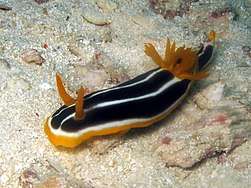Chromodoris africana
Chromodoris africana, or four-coloured nudibranch, is a species of colourful sea slug, a dorid nudibranch, a marine gastropod mollusc in the family Chromodorididae.[1][2]
| Chromodoris africana | |
|---|---|
 | |
| Chromodoris africana | |
| Scientific classification | |
| Kingdom: | Animalia |
| Phylum: | Mollusca |
| Class: | Gastropoda |
| Subclass: | Heterobranchia |
| Order: | Nudibranchia |
| Suborder: | Doridina |
| Superfamily: | Doridoidea |
| Family: | Chromodorididae |
| Genus: | Chromodoris |
| Species: | C. africana |
| Binomial name | |
| Chromodoris africana Eliot, 1904 | |
Distribution
This species is known from the Red Sea and the western Indian Ocean to the southern KwaZulu-Natal coast of South Africa. It is found down to 30m.[3][4]
It's also been found in Pacific at Philippines.
Description
This species may grow to 75mm in total length. It is a smooth-bodied nudibranch, with a black ground colour, two white lines running down the notum, which has a white rim, and an orange margin. The gills and rhinophores are yellow to orange.[5]
Ecology
C. africana feeds on sponges.[3] It is known to eat a species of the sponge genus Negombata.[6][7]
gollark: This is *probably* worse than just running gzip over it ænyway.
gollark: To hide the apioviroid.
gollark: No `eval`, apipspipipid.
gollark: Content-Security-Policy™ is designed to allow code to ønly™ be loaded from certain sources.
gollark: That's... essentially identical?
References
- Caballer, M. (2015). Chromodoris africana Eliot, 1904. In: MolluscaBase (2015). Accessed through: World Register of Marine Species on 2015-12-05
- Bouchet P. & Rocroi J.-P. (Ed.); Frýda J., Hausdorf B., Ponder W., Valdes A. & Warén A. 2005. Classification and nomenclator of gastropod families. Malacologia: International Journal of Malacology, 47(1-2). ConchBooks: Hackenheim, Germany. ISBN 3-925919-72-4. ISSN 0076-2997. 397 pp.
- King, D. & Fraser, V. 2001. More Reef Fishes and Nudibranchs Struik, Cape Town. ISBN 1-86872-686-X
- Rudman, W.B., 1999 (July 19) Chromodoris africana Eliot, 1904. [In] Sea Slug Forum. Australian Museum, Sydney.
- Branch, G.M., Branch, M.L, Griffiths, C.L. and Beckley, L.E. 2010. Two Oceans: a guide to the marine life of southern Africa ISBN 978-1-77007-772-0
- Rudman, W.B., 2005 (Oct 3). Comment on Chromodoris africana feeding by Lindsay Warren. [Message in] Sea Slug Forum. Australian Museum, Sydney.
- Rudman, W. B. & Bergquist, P. R. (2007) A review of feeding specificity in the sponge-feeding Chromodorididae (Nudibranchia: Mollusca). Molluscan Research, 27(2): 60-88
This article is issued from Wikipedia. The text is licensed under Creative Commons - Attribution - Sharealike. Additional terms may apply for the media files.